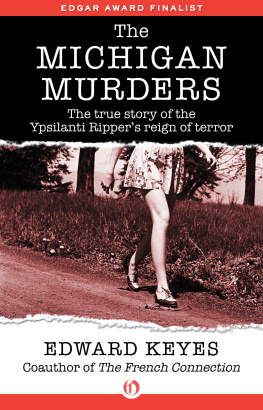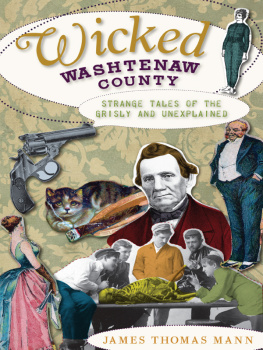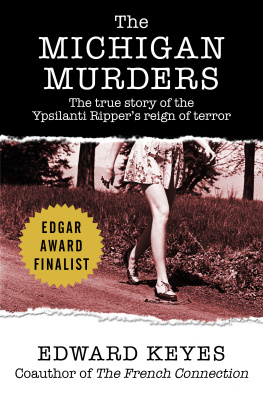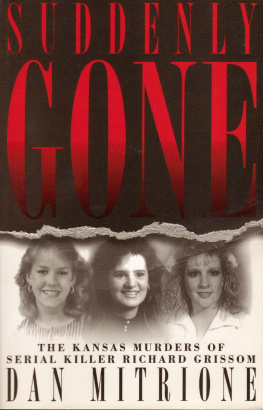The Michigan Murders
Edward Keyes

To Della Agnes Murray Walsh,
a grand lady who gave me my beloved Eileen;
who in turn honored me with Steve and Dara and Ed and Terry and
Kenan and Jeanine and Lisa and Tom
all of whom have put up with me for so long,
hoping for the best
Author Preface
What follows is true.
A few years ago, a normally peaceful mid-American community was wracked by a succession of inexplicable murders. The victimsseven young femalesranged in age from thirteen to twenty-three, each killed with unspeakable savagery.
The primary locale was Washtenaw County, Michigan, not far west of Detroit, seat of the University of Michigan at Ann Arbor and Eastern Michigan University in adjoining Ypsilanti. All the murders occurred within this twenty-five-square-mile area. The time span was from July of 1967 through July of 1969. Those two years became a period of maddening frustration and humiliation for policemen tormented by the case. It was also an unendurable crisis for those who looked to them for protection. As an inquisitive reporter and writer, I could not help but wonder how so average a community had dealt with so prolonged a period of anxiety and fear: how individuals were affected, by what misplacement of circumstances theyd become involved, where these tragedies had left them. And, of course, who had killed. And why.
It turned into a three-year project. I strove to recreate the situations, the scenes, the moods as they were when they were happening, as authentically as it was possible to do after the fact. What follows, then, is factual to the very best of my ability. But it does not, cannot, represent all the truth. For no matter how hard one may try, however deep the most enterprising reporter may dig, it is rarely possible to find out everything one wants to know and, by the same token, one often turns up facts that in the end prove extraneous and must be discarded as irrelevant to the central theme. But everything here described did happen, and the account is limited only by my own powers of description and interpretation.
There is one element of fiction knowingly presented, nonetheless, and it is important for the reader to know of it. True names are used only of public officials and certain private individuals drawn unofficially into these events, and of police officers involved (with three exceptions, so as to safeguard decent reputations). Identifications of all other principals have been disguisedof the victims, their families and friends; of bystanders, witnesses, suspects; even of the one finally accused and tried. All these persons, not least the family of the convicted murderer, now that the horror is over (although for some the trauma may never be), have their own lives to lead, their own circles of peaceful association to protect and cherish. I have seen no need to expose any of them further to needless aggravation or harassment from either the unthinking or the malicious. To those who do not know them, their true names will not be significant to the drama in any case.
I will burden you here with practically none of the usual formal acknowledgments. Having spent an aggregate of six full months in Michigan, having interviewed and talked with many hundreds of helpful individuals, having been permitted access to countless volumes of records both public and confidential, I see hardly any way to begin, or end, such a list of all to whom I owe gratitude.
There are two warranting special mention nonetheless. One is the Michigan State Police as an organizationtough, uncompromising, one of the proudest and most capable law-enforcement agencies I have encountered anywherewithout whose thoughtful forbearance and subtle approval my efforts might have run into many a dead end.
The other is an erudite, interested, enthusiastic gentleman who had himself closely followed and noted many of these events before Id ever entered upon the scene, and in whose perceptive insights I found much value. To Professor Paul McGlynn of Eastern Michigan University, my thanks and warm respects.
All othersmany of whom deserve no less recognitionwill find themselves in the narrative (appropriately, I trust), even if many will have to accommodate to their new identities. Each has contributed to what I hope all will find to be an accurate and sensitive representation of how it was in the time of The Michigan Murders.
Edward Keyes
New York 1976
CHAPTER 1
Ypsilanti, Michigan. July 10, 1967. Hot, quiet, stagnant.
Marilyn Pindars younger sister Sheila received the call. It was Nanette Langois, Marilyns roommate. Had the Pindars heard from Marilyn? She had not come back to the apartment on Sunday night and had not shown up for work yet on Monday morning. Probably nothing to worry about, but
Sheila Pindar, an alert, vivacious eighteen-year-old, was alarmed. She and a couple of friends had dropped by the apartment a little after 7:30 the previous evening, to find her sister out, and after waiting for a few minutes, had left, asking to have Marilyn call home when she got in. Now she learned that Marilyn had returned to the apartment ten or fifteen minutes later, puttered about for a few minutes, and then gone out to get some air. Nanette had not seen or heard from her since. Neither, it now began to appear, had anyone else who might have been expected to.
Sheila pondered this, then decided to tell her mother. Margaret Pindar got into her car at once and sped the seven miles north to her daughters apartment building at 413 Washtenaw Avenue, a tree-lined street in the heart of Ypsilanti, only a few blocks from the campus of Eastern Michigan University, where Marilyn and her roommate were students.
As Mrs. Pindar drove into the tarmac parking area in front, she noticed that her daughters Comet was not in its usual reserved space, but at the opposite side of the lot. Using her spare keyshe liked to be able to drop in every so often when the girls were out, to straighten up or bring things they might needshe went through the apartment with a mothers practiced eye and noted that her daughters belongings seemed in order. Then she picked up the phone and called Nanette at the universitys Field Services Office, where she and Marilyn worked part-time. Marilyn still had not reported in. Mrs. Pindar asked what she was wearing when she went out last on Sunday evening. Nanette said it was the orange tent dress with white polka dots and her leather-and-straw sandals. Mrs. Pindar checked Marilyns closet. The dress and sandals were not there. Also, there was no sign anywhere of either her apartment keys or her car keys. Yet she had not taken her purse containing her drivers license.
Margaret Pindar next telephoned her husband at the bronze plant in Flat Rock, where he was director of engineering.
Charles Pindar listened quietly. He suggested that Margaret telephone the police first, then go to Ypsilanti headquarters personally. He would leave the plant at once and join her there.
At police headquarters the Pindars concern turned to frustration. Marilyn Pindar had been missing less than twenty-four hours. Police are not aroused to quick anxiety over a young person dropping out of sight for a day or twoparticularly in a town like Ypsilanti.
Ypsilanti and Ann Arbor, Michigan, are university towns. Ypsilanti harbors Eastern Michigan University, which in 1967 had an enrollment of some 13,000 students. Just to the west, comprising a significant part of the city of Ann Arbor, is the University of Michigan, with almost three times as many students as E.M.U. Thus together, within a range of barely ten miles, the two communities swarmed ten months of the year with close to 50,000 young people, mostly transient, plus additional thousands of high-school age and younger.














